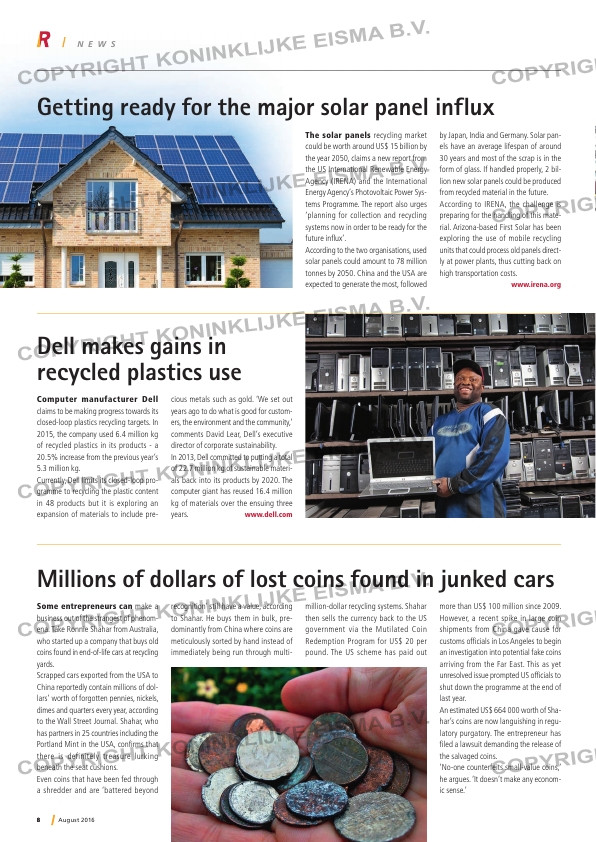Page 8 from: August 2016

8 August 2016
N E W S
Getting ready for the major solar panel influx
The solar panels recycling market
could be worth around US$ 15 billion by
the year 2050, claims a new report from
the US International Renewable Energy
Agency (IRENA) and the International
Energy Agency’s Photovoltaic Power Sys-
tems Programme. The report also urges
‘planning for collection and recycling
systems now in order to be ready for the
future influx’.
According to the two organisations, used
solar panels could amount to 78 million
tonnes by 2050. China and the USA are
expected to generate the most, followed
by Japan, India and Germany. Solar pan-
els have an average lifespan of around
30 years and most of the scrap is in the
form of glass. If handled properly, 2 bil-
lion new solar panels could be produced
from recycled material in the future.
According to IRENA, the challenge is
preparing for the handling of this mate-
rial. Arizona-based First Solar has been
exploring the use of mobile recycling
units that could process old panels direct-
ly at power plants, thus cutting back on
high transportation costs.
www.irena.org
Dell makes gains in
recycled plastics use
Computer manufacturer Dell
claims to be making progress towards its
closed-loop plastics recycling targets. In
2015, the company used 6.4 million kg
of recycled plastics in its products – a
20.5% increase from the previous year’s
5.3 million kg.
Currently, Dell limits its closed-loop pro-
gramme to recycling the plastic content
in 48 products but it is exploring an
expansion of materials to include pre-
cious metals such as gold. ‘We set out
years ago to do what is good for custom-
ers, the environment and the community,’
comments David Lear, Dell’s executive
director of corporate sustainability.
In 2013, Dell committed to putting a total
of 22.7 million kg of sustainable materi-
als back into its products by 2020. The
computer giant has reused 16.4 million
kg of materials over the ensuing three
years. www.dell.com
Millions of dollars of lost coins found in junked cars
Some entrepreneurs can make a
business out of the strangest of phenom-
ena. Take Ronnie Shahar from Australia,
who started up a company that buys old
coins found in end-of-life cars at recycling
yards.
Scrapped cars exported from the USA to
China reportedly contain millions of dol-
lars’ worth of forgotten pennies, nickels,
dimes and quarters every year, according
to the Wall Street Journal. Shahar, who
has partners in 25 countries including the
Portland Mint in the USA, confirms that
there is definitely treasure lurking
beneath the seat cushions.
Even coins that have been fed through
a shredder and are ‘battered beyond
recognition’ still have a value, according
to Shahar. He buys them in bulk, pre-
dominantly from China where coins are
meticulously sorted by hand instead of
immediately being run through multi-
million-dollar recycling systems. Shahar
then sells the currency back to the US
government via the Mutilated Coin
Redemption Program for US$ 20 per
pound. The US scheme has paid out
more than US$ 100 million since 2009.
However, a recent spike in large coin
shipments from China gave cause for
customs officials in Los Angeles to begin
an investigation into potential fake coins
arriving from the Far East. This as yet
unresolved issue prompted US officials to
shut down the programme at the end of
last year.
An estimated US$ 664 000 worth of Sha-
har’s coins are now languishing in regu-
latory purgatory. The entrepreneur has
filed a lawsuit demanding the release of
the salvaged coins.
‘No-one counterfeits small-value coins,’
he argues. ‘It doesn’t make any econom-
ic sense.’



